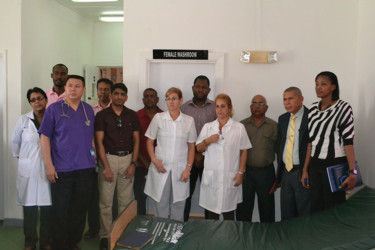Minister of Public Health Dr George Norton yesterday visited the Leonora Cottage Hospital to discuss the remodeling required for the maternity ward so it can be functional again.
During the visit, he reminded attendees that the primary focus is to ensure safe deliveries and reduce maternal deaths. The cost and time for commencement of the remodeling works was not immediately known but it was said that this will be determined following discussions with the engineer and the Regional Executive Officer (REO).
The proposal to extend the maternity ward to accommodate prenatal and post-natal care came following a visit by President David Granger on Christmas Day. The president was not pleased with the condition of the facility.

During the visit yesterday, it was pointed out that the hospital’s maternity ward—which consists of a delivery room, nurse area and a ward that can house about eight beds—needs an air conditioning unit, lighting and an operating theatre if possible.
“We want to get the hospital back to the stage where mothers come to get babies and go home healthy without no worries,” Norton said.
Among those present during the tour was the ministry’s engineer and regional officials, who participated in a meeting afterwards to decide what will be done. The outcome of the meeting was not revealed but Norton said he will be meeting with the president today to propose his plan for the remodeling.
According to the minister, the goal is to reestablish the service that was once available. “There might be a gynecologist here and they might be able to do a C-section or high risk delivery cases but we also need operating rooms, instruments and sterilisation unit to get quality health care,” Norton said.
Savitri Chandrabrose, a staff nurse who has been working at the facility since the 1980s and who was reemployed after retirement, said there was once a full-fledged maternity ward with as much as 55 deliveries being done in one month. Previously, she said, it was the only hospital that provided delivery services in the region but the shortage of mid-wives contributed to the closure of the maternal section of the hospital.
The last delivery was done in 2008, when the maternity ward was just commissioned,Chandrabrose revealed. She said other deliveries were done but in the open ward. In many cases, the nurse added, mothers delivered at the institution then were transferred to the Georgetown Public Hospital (GPH) for further care in light of the unavailability of accommodation at Leonora.
A neonatal unit is also slated to be part of the remodeling so that babies who are delivered early can get the special care needed.
According to the minister, his ministry is focusing on a policy which will concentrate on maternal health in various ways. These include the expansion of the maternity leave period given to mothers and even paternity leave.
Norton said he is of the belief that fathers should be allowed to get more time to assist mothers. He added that he would want fathers to actually witness the process of birth, which he said would make a difference in parenting.
Norton also highlighted the ongoing problem where many babies die each month because of maternal sepsis. “Every month too [many] babies are dying because of sepsis and it is because of this that the neonatal unit of GPH and New Amsterdam Hospital was closed down,” he said. The unit at the West Demerara Regional Hospital (WDRH) was also shut but later reopened.
“Most complications we have in maternal deaths recently is that either the mothers arrive too late, resulting in no time for the surgeons to operate because they come from far distances,” Norton said. “If Linden could have had no maternal death for half of a decade, then it can happen anywhere else in Guyana and we are working towards that,” he added.
“We made a commitment, not a promise to the people and that is to improve… and it is one of our main focus,” he emphasised.
REO Dennis Jaikaran said a major focus of Region 3 is on health. He related that last week, a team visited the hospital to ensure that everything is in place as required.
“In terms of health, we are growing and improving tremendously and within the next six months all other areas will be addressed adequately,” he said.
The WDRH is one of three public health facilities earmarked for upgrading with funding from the Indian government. The other two are the Suddie and Bartica hospitals.









